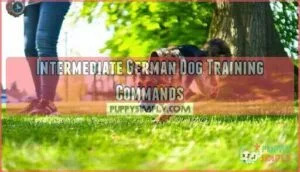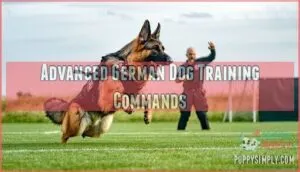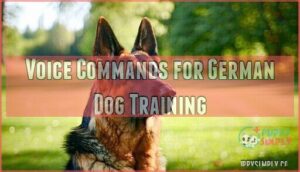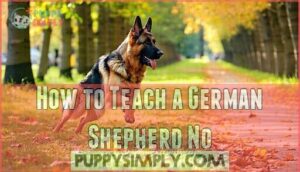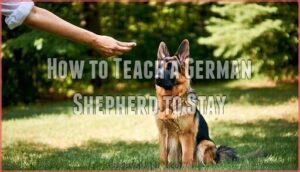This site is supported by our readers. We may earn a commission, at no cost to you, if you purchase through links.
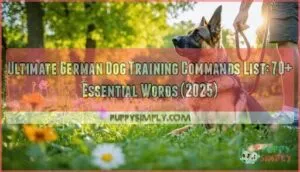
Start with basics like "Sitz" (sit), "Platz" (down), and "Bleib" (stay). These commands aren’t just fancy foreign words—they’re powerful tools that cut through distractions better than English.
German shepherds and other breeds respond exceptionally well to these crisp, distinct sounds. Master "Komm" (come), "Aus" (drop it), and "Fass" (fetch) for everyday control.
The key is consistent pronunciation and timing. Most dogs pick up these commands faster than you’d expect, especially when you pair them with clear hand signals and positive reinforcement techniques.
Table Of Contents
- Key Takeaways
- Basic German Dog Training Commands
- Intermediate German Dog Training Commands
- Advanced German Dog Training Commands
- Using Hand Signals in German Dog Training
- Voice Commands for German Dog Training
- How to Teach Your German Shepherd to Come
- How to Teach a German Shepherd No
- How to Teach a German Shepherd to Stop
- How to Teach a German Shepherd to Sit
- How to Teach a German Shepherd to Stay
- Frequently Asked Questions (FAQs)
- How Long Should I Spend Training My German Shepherd Each Day?
- What Are the Benefits of Using German Commands for My Dog?
- How Do I Know if My German Shepherd Understands the Commands?
- Are There Any Special Considerations When Training a German Shepherd?
- What is the German dog command Fass?
- What are the German commands for dog training?
- How to tell a dog to heal in German?
- What is the German method of dog training?
- How long should I spend training my German Shepherd each day?
- What are the benefits of using German commands for my dog?
- Conclusion
Key Takeaways
- You’ll build stronger communication with your dog using German commands like "Sitz" (sit), "Komm" (come), and "Bleib" (stay) because these distinct sounds cut through everyday conversation distractions better than English words.
- You should practice 15-30 minutes daily in short, focused sessions rather than marathon training blocks—your dog’s attention span and learning improve dramatically with consistent, bite-sized practice sessions.
- You’ll get faster results by combining clear German pronunciation with immediate positive reinforcement and hand signals, since dogs respond to confident delivery and timing more than perfect grammar.
- You can start with basic commands and gradually progress to intermediate ones like "Langsam" (slow) and advanced protection commands, but you’ll need professional guidance for specialized training like "Fass" (attack).
Basic German Dog Training Commands
Starting with basic German commands gives your dog a solid foundation for advanced training. Begin with essential words like "Sitz" (sit) and "Komm" (come).
Command pronunciation matters – practice saying each word clearly before training sessions. Early socialization helps your dog respond better to German dog commands.
Master your pronunciation first—your dog reads confidence, not perfect German accents.
Training consistency beats sporadic practice every time. Focus on reward timing – praise immediately when your dog follows basic German commands correctly.
Common beginner mistakes include using multiple languages during the same session. One should also consider minimizing distractions during these sessions.
Master these dog commands in German before moving to complex instructions.
Intermediate German Dog Training Commands
You’ve mastered the basics—now it’s time to step up your game with intermediate commands that’ll turn your dog into a true German shepherd.
These German dog commands focus on Duration Training and Problem Solving skills your pup needs for real-world situations.
Mastering commands like "Nein" (no) can prevent unwanted actions, but it’s also important to teach your dog basic commands like Bleib.
Start with "Krabbeln" (crawl) and "Steh" (stand) to build Command Chains.
Practice "Langsam" (slow) during walks for better control.
The key is Generalization Skills—your dog should respond whether you’re at home or the park.
Add Distraction Work by practicing these intermediate commands around other dogs or people.
Remember, consistency beats perfection every time.
Advanced German Dog Training Commands
Advanced German commands reveal your dog’s full potential in areas like protection training, scent work, and off-leash control. Commands like "Fass" (attack) or "Such" (track) are essential for police K9 training or specialized tasks.
Here’s how to start:
- Use clear, consistent tones and hand signals for commands like "Aus" (let go) or "Pass Auf" (guard alert).
- Reward success with treats or praise to reinforce behaviors during scent tracking or object retrieval.
- Gradually introduce distractions to master emergency recall and advanced off-leash control.
German Shepherds are often trained using these commands, highlighting the importance of German in certain dog training programs, as seen in the link to importance of German, which provides more information on German dog training commands and their application in various training scenarios.
Using Hand Signals in German Dog Training
Hand signals boost your German dog commands training effectiveness substantially.
Combining signals with verbal cues like "Sitz" creates powerful communication.
Your German shepherd commands become crystal clear when you pair an open palm gesture with "Bleib".
Distance signals work especially well – point down for "Platz" from across the yard.
Some breed predispositions make certain dogs more visual learners.
When troubleshooting signals, guarantee consistency among family members.
Start with basic gestures before advancing to complex German commands list items.
Positive reinforcement techniques are vital for success.
Your dog training German sessions become more engaging and professional-looking.
Voice Commands for German Dog Training
Your voice becomes your dog’s compass when you master German commands.
Command pronunciation matters more than perfect German—your dog reads tone inflection and command clarity, not grammar.
Here’s how to nail multilingual training:
- Keep commands short – "Sitz" beats lengthy explanations
- Stay consistent – Use the same German word every time
- Project confidence – Dogs respond to authoritative tones
- Practice daily – Regular sessions build strong associations
German shepherd commands work best with firm, clear delivery.
Positive reinforcement, including praise and affection, can also be effective rewards.
Whether you’re teaching basic Hund commands or advanced dog commands in German, your vocal consistency creates breed specificity success.
How to Teach Your German Shepherd to Come
Teaching your German Shepherd "Komm" builds reliable recall that could save their life.
Start indoors where distractions are minimal, then gradually increase challenges.
Use high-value treats and enthusiastic praise when they respond correctly.
German shepherd commands work better than English because they’re distinct from everyday conversation.
Positive reinforcement, including verbal cues and praise, is also essential for success.
Key steps for success:
- Practice short sessions multiple times daily for consistency
- Never call "Komm" unless you can enforce the command
- Reward immediately when they reach you, not when they start coming
Recall reliability improves with patience and proper distraction training techniques.
How to Teach a German Shepherd No
Most German Shepherd owners struggle with teaching "Nein" effectively, but mastering this essential German dog command transforms your training success.
Correction timing proves vital – say "Nein" immediately when problem behaviors occur. Your German Shepherd learns through consistent repetition and clear boundaries. Use a firm tone without shouting, then redirect to alternative commands like "Sitz" or "Platz."
Consistency importance can’t be overstated in German dog training. High energy levels require ongoing stimulation.
- Master Nein nuances – Use different tones for varying severity levels
- Perfect correction timing – React within 2-3 seconds of unwanted behavior
- Establish clear boundaries – Consistent rules prevent confusion and strengthen obedience
- Combine with positive redirection – Follow "Nein" with acceptable alternative commands
How to Teach a German Shepherd to Stop
After mastering "Nein," your German Shepherd needs solid impulse control with the "Halt" command. This emergency stop command can prevent dangerous situations during walks or off-leash training.
- Start with leash pressure – Use gentle backward tension while saying "Halt" to create physical association with stopping
- Practice distraction training – Begin in quiet spaces, then add distractions like toys or other dogs
- Use reinforcement schedules – Reward immediately when your dog stops, then gradually delay treats
- Build emergency stop reliability – Practice sudden "Halt" commands during play sessions
German commands work because they’re distinct from everyday conversation. Regular exercise can help prevent destructive behaviors.
How to Teach a German Shepherd to Sit
Breaking down the "Sitz" command doesn’t have to feel like rocket science. Teaching your German Shepherd to sit in German creates a foundation for all future German commands and basic commands training.
Start with lure training by holding a treat close to your dog’s nose, then slowly lift it over their head. As their bottom naturally touches the ground, say "Sitz" clearly and reward immediately. This technique works because dogs instinctively follow food with their eyes and body.
Here’s your step-by-step approach:
- Practice duration increase – Begin with 3-second sits, gradually extending to 30 seconds as your dog masters the position
- Add distraction proofing – Practice "Sitz" with family members walking around, toys nearby, or mild outdoor distractions
- Focus on troubleshooting Sitz – If your dog jumps instead of sitting, lower the treat and move slower
Early socialization helps your German Shepherd respond to German shepherd commands in various environments. Remember, consistency beats perfection every time when establishing reliable dog training habits. It’s also important to remember that positive reinforcement methods are key to success.
How to Teach a German Shepherd to Stay
Your German Shepherd masters sit beautifully. Now let’s build on that foundation with "Bleib" (stay). This German command teaches patience and self-control, essential for any well-trained dog.
Start with your pup in the sit position. Hold your palm out like a stop sign while saying "Bleib" firmly. Take one small step back, wait two seconds, then return with praise and treats. Gradually increase Stay Distance and Bleib Duration as your German Shepherd improves.
A consistent release word, such as "Okay," is also vital to avoid confusion.
Here’s your step-by-step training approach:
- Position your dog – Begin with a solid sit command, keeping your German Shepherd focused on you
- Use Stay Hand Signals – Extend your palm forward while clearly saying "Bleib" in a calm, authoritative voice
- Practice Distraction Training – Add mild distractions like toys or sounds once basic commands are solid
- Apply Stay Reinforcement – Reward immediately when your dog holds position, building positive associations with German commands
Frequently Asked Questions (FAQs)
How Long Should I Spend Training My German Shepherd Each Day?
Rome wasn’t built in a day, and neither is your German Shepherd’s training.
You’ll want to dedicate 15-30 minutes daily to focused sessions.
Short, consistent training beats marathon sessions that’ll leave both of you exhausted and frustrated.
What Are the Benefits of Using German Commands for My Dog?
Using foreign commands prevents confusion when you’re talking to others around your dog.
Your pup won’t accidentally respond to everyday conversation.
It also makes training look impressive and helps create clearer communication between you both, which prevents confusion and makes training look impressive.
How Do I Know if My German Shepherd Understands the Commands?
Like a compass needle finding north, your German Shepherd’s body language reveals understanding.
Watch for immediate responses, focused eye contact, and consistent obedience.
They’ll respond quickly without hesitation when commands truly click. Watch for immediate responses, focused eye contact, and consistent obedience.
Are There Any Special Considerations When Training a German Shepherd?
German Shepherds need consistent, firm leadership since they’re naturally dominant.
You’ll want shorter training sessions due to their high intelligence – they get bored easily.
Start early and stay patient with their strong-willed nature.
What is the German dog command Fass?
Fass is the German attack command that tells your dog to bite or apprehend a target.
It’s primarily used in protection training and police work.
You shouldn’t teach this command without proper professional guidance.
What are the German commands for dog training?
Think of German commands as your dog’s secret code language.
You’ll use "Sitz" for sit, "Komm" for come, "Bleib" for stay, "Platz" for down, and "Fuß" for heel.
These clear sounds prevent confusion.
How to tell a dog to heal in German?
To tell your dog to heel in German, use "Fuß" (pronounced "fooss").
This command keeps your dog walking calmly beside you.
Practice consistently with treats and praise until they master this essential obedience skill.
What is the German method of dog training?
You’ll use firm, consistent commands with positive reinforcement.
This method emphasizes short training sessions, clear pronunciation, and immediate rewards.
It builds trust through patience while teaching obedience without harsh punishment or confusion, using positive reinforcement.
How long should I spend training my German Shepherd each day?
Your furry genius needs bite-sized learning sessions to avoid mental overload.
Aim for two 10-15 minute training blocks daily.
German Shepherds thrive with consistent, short bursts rather than marathon sessions that’ll leave you both frustrated.
What are the benefits of using German commands for my dog?
German commands prevent confusion with everyday English words, making your dog’s responses sharper and more reliable.
You’ll sound impressive at the dog park, and your pup won’t accidentally obey random conversations.
Conclusion
Maybe you’re thinking German commands are too complicated for your dog to learn.
Don’t worry—your pup will surprise you with how quickly they pick up these distinct sounds. This ultimate German dog training commands list gives you everything needed to start building better communication with your dog today.
Practice consistently, stay patient, and watch your furry friend respond with impressive focus.
German commands aren’t just for German Shepherds—they work wonderfully for any breed ready to learn, and with consistent practice, you can achieve great results.
- http://www.deafdogs.org/
- https://www.psychologytoday.com/gb/blog/canine-corner/202201/can-dogs-distinguish-human-language-other-sounds
- https://pets.webmd.com/dogs/features/dog-training-positive-reinforcement-alpha-dog-method
- https://www.akc.org/expert-advice/dog-breeds/puppy-training-timeline-for-your-german-shepherd-dog/
- https://forvo.com/languages/de/

